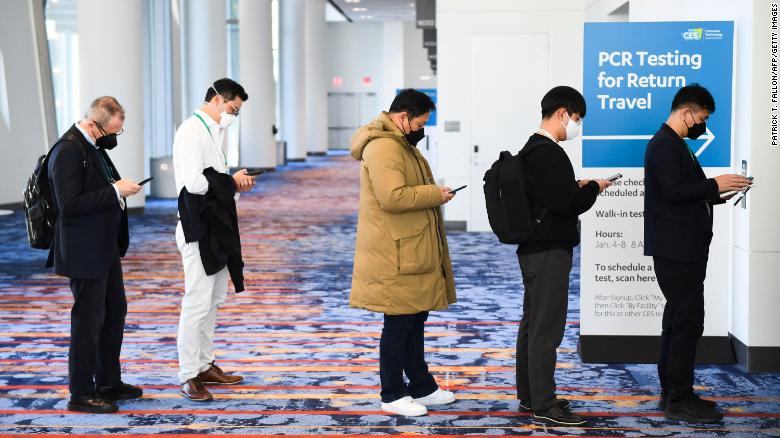As Covid-19 hospitalizations hit new highs in the US, more and more states and health care systems are cutting services and relying on the National Guard to fill staffing gaps.
The rise of the omicron variant, which was first detected in the US just over six weeks ago, has left frontline workers in the medical sector and others at higher risk of exposure. With healthcare employees needing time off to isolate and recover, the need to treat people with COVID-19 remains.
In Washington state, Gov. Jay Inslee said Thursday that hospitals will temporarily halt non-urgent procedures “so that capacity and staff can be dedicated to emerging needs, people who need it right now.”
More than 155,900 Americans are hospitalized with Covid-19, according to data Thursday from the US Department of Health and Human Services, breaking records set in last winter’s uptick. And hospitals need additional staff to help provide care.
In Wisconsin, members of the National Guard will be trained as certified nursing assistants to provide support to hospitals and nursing homes, Gov. Tony Evers said.
“We estimate that the first round of staffing and relief deployment will allow skilled nursing facilities to open 200 or more beds by the end of February,” Evers said Thursday as the state announced a record number of confirmed cases.
“Our health care providers are beyond exhausted. We just don’t have enough staff to take care of everyone who is sick,” said Lisa Greenwood, associate dean of nursing at Madison College, who is training Guard members.
Nineteen states report less than 15% capacity remaining in their intensive care units, according to HHS data on Thursday: Alabama, Arizona, Delaware, Georgia, Indiana, Kentucky, Massachusetts, Mississippi, Missouri, Nevada, New Hampshire, New Mexico , North Carolina, Ohio, Oklahoma, Pennsylvania, Rhode Island, Texas, and Vermont.
‘No one is untouchable’
Since the rise of omicron, which complicated a continued rise of the delta variant, states have relied on the military and federal emergency teams to back up absences.
Before the New Year, states including Delaware, Hawaii, Maine, Massachusetts, New Hampshire and New York called in the National Guard to help with medical and non-medical tasks.
In Ohio, more than 2,000 National Guard members have been deployed as cases continue to rise. Now, with hospitalizations at an all-time high, authorities are urging residents to protect themselves from infection.
“In this omicron surge, you have to remember that no one is untouchable,” state health department director Dr. Bruce Vanderhoff said Thursday. He asked people to only go to the hospital in case of a real emergency as staff shortages remain critical.
More federally deployed medical teams will soon head to six states — Michigan, New Jersey, New Mexico, New York, Ohio and Rhode Island — to help hospitals fight COVID-19, President Joe Biden announced. Thursday.
Biden announced plans last month to mobilize an additional 1,000 military medical personnel to help overwhelmed hospitals.
The assistance needed with staffing is not just limited to health care facilities. Many school districts have had to make difficult decisions about returning to in-person learning after the break, and the increase has affected educational staff.
Montgomery County Public Schools, the largest school district in Maryland, has submitted a formal request for help from the National Guard to address a shortage of school bus drivers, district spokesman Chris Cram told Citizen Free Press Thursday.
Earlier this week, nearly 100 of the district’s school bus routes were affected by driver shortages, but that number is now down to 29 routes as of Thursday, Cram said.
There are still problems with the tests
While health experts are hopeful the surge will soon subside, the sheer volume of infections continues across the country. Confirmed positive cases of Covid-19 have risen to a daily average of 771,580 in the US, according to data from Johns Hopkins University, more than three times the peak average last winter.
Mitigating the transmission of COVID-19 remains paramount, and officials are working to overcome a shortage of rapid COVID-19 tests so those who are asymptomatic can know to quarantine.
In Nevada, Gov. Steve Sisolak announced the state has ordered more than half a million home antigen test kits that will be available at no cost and distributed near the end of the month through “community partners” to be announced later. .
“This will ensure that as we live with Covid, the supply chain doesn’t dictate access for Nevadans,” Sisolak said Thursday.
However, not all cases confirmed through rapid testing are tracked and recorded, meaning the number of people with covid-19 may be much higher.
Health leaders in Oregon say the omicron variant has become so widespread that it is outpacing their ability to keep track of how many people are infected.
“We know that our daily case counts are missing many home test results and, in the face of the highly transmissible omicron variant, our case data is also missing many undiagnosed cases,” said the director of the Health Authority. of Oregon, Patrick Allen, at a briefing Thursday.
“To be completely transparent, we are likely approaching the maximum capacity of our testing system to identify cases.”
Instead of interviewing people for contact tracing, Allen said they will focus on tracking outbreaks in high-risk settings, asking people with positive test results to voluntarily report them to the state through a website and a direct line.
“Hospitalizations and deaths will continue to represent our most reliable and meaningful metric,” Allen said.
Nationwide deaths have lagged behind the worst of last winter’s surge, as the country has averaged 1,817 Covid-19 deaths per day over the past week, data from Johns Hopkins University shows. The maximum daily average was 3,402 a year ago, on Jan 13, 2021.

